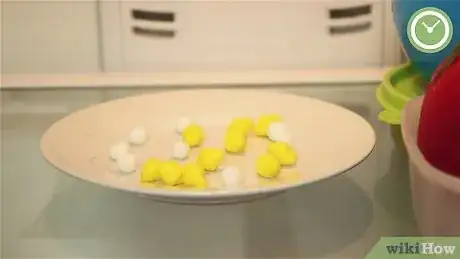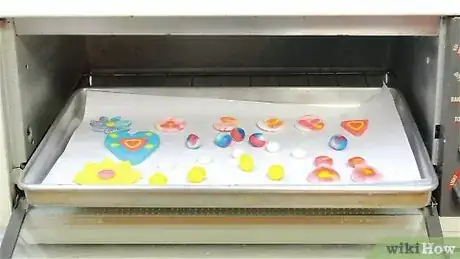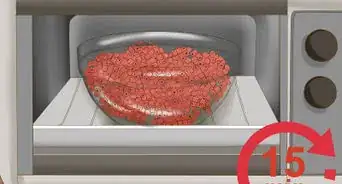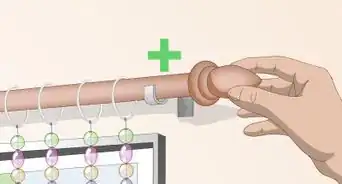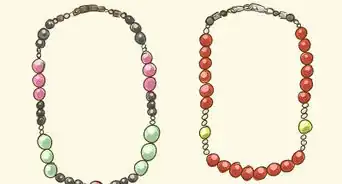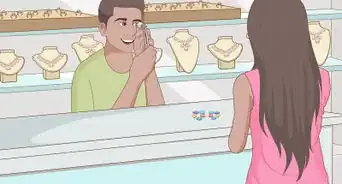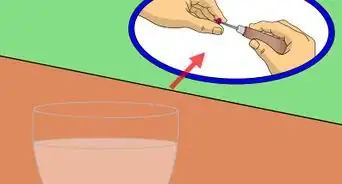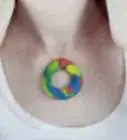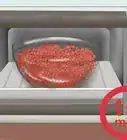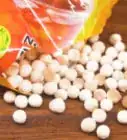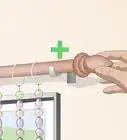This article was co-authored by wikiHow Staff. Our trained team of editors and researchers validate articles for accuracy and comprehensiveness. wikiHow's Content Management Team carefully monitors the work from our editorial staff to ensure that each article is backed by trusted research and meets our high quality standards.
There are 7 references cited in this article, which can be found at the bottom of the page.
The wikiHow Video Team also followed the article's instructions and verified that they work.
This article has been viewed 122,744 times.
Learn more...
Making your own polymer clay beads is a fun way to pass time, and you can then use the beads to make personalized jewelry, custom gifts, and gorgeous decorations and accessories. While you can buy pre-made beads from a craft store, homemade beads add a personal touch and artistic flair to the jewelry that you can never achieve with store-bought beads. Homemade beads also allow for more creativity and uniqueness of style, especially when you master the basic process and begin to explore more complex patterns and shapes. Making beads is fun and easy, and even makes a great activity for kids on a rainy afternoon or as a birthday party craft.
Steps
Creating Basic Beads
-
1Assemble your tools. To create beads, you will need polymer clay in colors of your choosing, a hard and flat surface, a flat blade or craft knife, and a toothpick. Once you have created your beads, you’ll also need to bake them and finish them (see part three).
- A piece of tile or glass works well for the hard, flat surface.
- Instead of the toothpick, you can also use an electric drill with a one-eighth-inch drill bit to drill holes in the beads.
-
2Size your beads. To create uniform beads that are all the same size, cut off a one-inch (25 mm) slice of clay and roll it out into a sheet that’s one-eighth inch (three mm) thick. Use a shape cutter to punch out chunks of clay that are all the same size.[1]
- If you want beads that are different sizes, you can either use cutters in varying sizes, or simply cut chunks of clay from the block using your eye to measure. The great thing about homemade beads is that you can make them any size, shape, or design you like!
Advertisement -
3Condition the clay. Work the chunks of clay in your hands by rubbing each one between your palms. Conditioning helps to warm the clay, gets rid of cracks, and makes the clay more pliable and easier to shape and handle.[2]
- Always wash your hands before rolling white clay to avoid transferring dyes or colors to it.[3]
-
4Shape your beads. To create spherical beads, roll each bead individually between your palms to shape them into spheres. You can also make them more ovoid, roll them into cylinders, or shape them into cubes or other shapes.
- Always shape beads on a hard, flat surface.
-
5Refrigerate the beads. Stick all your beads in the fridge for 10 to 15 minutes. This will allow the clay to firm up, which will make it easier to punch holes in them.[4]
-
6Pierce holes in the beads. In order to be able to string your beads, you have to poke a hole in each one before it’s baked. With a toothpick, create a hole through the center of each bead. Don’t push the bead into the toothpick or shove the toothpick through the bead, as this will warp the bead. Instead:
- Screw the toothpick into the bead by rolling it between your fingers as you apply gentle pressure. Once you’ve worked the toothpick all the way through, pull it out and reinsert it through the other side to clean up the hole.[5]
- If you are going to use a drill to create holes after baking, skip this step and move on to baking.
Making Decorative Beads
-
1Create your own spiral cane. A cane is a log of clay with a design that runs through the center. When the cane is sliced into discs, each disc has the same design in the middle. Canes come in various shapes, such as cylindrical, cubic, triangular, and star-shaped.[6]
- Choose three different clay colors and cut off a half-inch (12 mm) slice from each block. Roll them all into individual cylinders of the same width and length.[7]
- Place the three cylinders together in a triangular log and twist the colors together. The more you twist, the more variation there will be in the cane.
- Roll the log back into a cylinder, and use your knife to slice off discs. Use the discs to create your beads.
-
2Use pre-made cane. You can buy cane that’s already got designs woven in, and this cane can be laid over top of a bead mold to create unique and intricate beads. For the bead molds, you can either roll your own basic beads as before (don’t poke holes just yet), or you can use wooden beads for a more lightweight finished product. Refrigerate the cane for 10 to 15 minutes before slicing it.
- Cut slices from the cane that are about the thickness of a nickel. The number of slices you need for each bead will depend on the size of the bead and the design you’re going for. Warm the slices in your hand and arrange them around the bead mold.
- Gently roll the wrapped bead around in your hand to seal the seams together. You can also use a knitting needle to roll the seams and seal the cane joints.
- When you have sealed the seams, shape your bead and poke the holes.[8] If you used a wooden bead as the mold, poke small holes in the cane to access the hole that’s already in the wooden bead.
-
3Make discs. Form your chosen clay into spherical balls by rolling it between your palms. On a hard, flat surface, place the ball between two layers of parchment paper. Use another hard, flat surface, such as a small sheet of acrylic or a stamp block, to apply even pressure to the clay. Press the clay until it forms a disc that’s about one-eight inch (three mm) thick. Refrigerate for 10 to 15 minutes.
- Once the clay has firmed up, remove it from the parchment paper and use your toothpick to poke a hole in each disc.[9]
-
4Create a pendant. Making a bead pendant is a combination of the basic bead and the cane bead process. Start by slicing a half-inch (12 mm) block of clay. Condition it by rolling it around in your hands. Roll it out into a sheet that’s about one-eighth inch (3 mm) thick.
- Then, decorate that slab with slices from your desired cane designs, just as you did when you were decorating your bead mold.[10]
- Use your hands to apply even pressure and press the cane into the clay beneath. Use a roller or knitting needle to join the seams of the cane together.
- Use a cutter to punch out your desired shape. You can also use a sharp knife to cut out a custom design. When you have your shape, punch a hole in the pendant.
-
5Use a bead roller. Alternatively you could use a bead roller. Measure out your clay using the guide included, then follow the instructions for many identical beads.
Finishing Your Beads
-
1Bake them. No matter what kind of beads, pendants, or discs you made, they must be finished with baking. This will set the clay so that the beads maintain the shapes and designs you’ve created. Always preheat your oven before baking, and follow the manufacturer’s instructions regarding baking times and temperatures. To bake your beads, you can:
- Arrange them on a parchment-lined baking sheet.
- Place the beads on a length of firm, straight wire. Then, suspend the wire from an oven-safe baking dish and bake the beads like that.[11]
- Once your baking time is up, remove the beads from the oven and allow them to cool completely before handling them.
-
2Drill holes. In case you chose not to poke holes in your beads before baking, now’s the time to create the holes. Work with each bead individually. Hold a bead steady on a hard surface with your thumb and forefinger. With your other hand, use the drill to carefully drill a hole through the center of the bead.[12]
-
3Sand each bead. Use a 400-grit (or higher) wet/dry sandpaper to remove any blemishes or fingerprints.
-
4Coat your beads. Since polymer clay forms a nice, durable finish when it cures, sealing your beads isn’t necessary.[13] However, if you choose to seal your beads, use a clean brush to apply a thin layer of polyurethane varnish to each bead. Allow them to dry before creating your jewelry.
Community Q&A
-
QuestionFor how long will I have the beads?
 Community AnswerPolymer clay doesn't mold or expire, so you will have them for a very long time. However, the beads may be fragile if they're thin, especially before they have cooled down after baking.
Community AnswerPolymer clay doesn't mold or expire, so you will have them for a very long time. However, the beads may be fragile if they're thin, especially before they have cooled down after baking. -
QuestionIs there another way to finish the beads other than baking in the oven? Like can you use a microwave or toaster oven instead?
 Community AnswerNo.
Community AnswerNo. -
QuestionHow long do I have to bake the beads for?
 CraftsmartTop AnswererThis depends on the size and thickness of the bead. Bake for at least the suggested amount of time that the manufacturer provides on the package. Sometimes it can be baked longer, but do not bake for a shorter amount of time. Usually this can be 10 - 30 minutes, but it varies.
CraftsmartTop AnswererThis depends on the size and thickness of the bead. Bake for at least the suggested amount of time that the manufacturer provides on the package. Sometimes it can be baked longer, but do not bake for a shorter amount of time. Usually this can be 10 - 30 minutes, but it varies.
Warnings
- Always bake your clay at the temperature directed by the manufacturer. Consider using a thermometer instead of your oven’s thermometer to keep an eye on the temperature.⧼thumbs_response⧽
- Always use caution when handling sharp tools and using hot ovens.⧼thumbs_response⧽
References
- ↑ https://www.youtube.com/watch?v=PJzkzmUlwWc
- ↑ https://www.youtube.com/watch?v=4AZlWI4EwOE
- ↑ https://www.youtube.com/watch?v=lxB4_kDG05g
- ↑ https://www.youtube.com/watch?v=4AZlWI4EwOE
- ↑ https://www.youtube.com/watch?v=lxB4_kDG05g
- ↑ http://www.jaedworks.com/clayspot/polyclay-faq/caning.html
- ↑ https://www.youtube.com/watch?v=lxB4_kDG05g
- ↑ https://www.youtube.com/watch?v=PJzkzmUlwWc
- ↑ http://crafts.tutsplus.com/tutorials/make-your-own-colourful-polymer-clay-necklaces--craft-8943
About This Article
To make polymer clay beads, start by rolling chunks of clay that are all the same size between your palms to make the clay more pliable. Then, shape the pieces into spheres, cylinders, or any other shape you want. Once the beads are formed, stick them in the refrigerator for 10-15 minutes to firm them up before using a toothpick to make a hole through the center of each bead. Next, put the beads on a tray, and bake them according to the directions on the clay packaging. When they’re done, sand them to remove any fingerprints or blemishes. For tips on how to make or use a spiral cane to create more decorative beads, scroll down!

